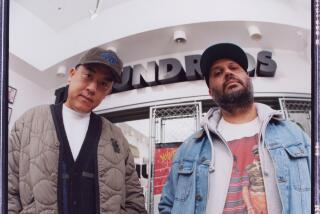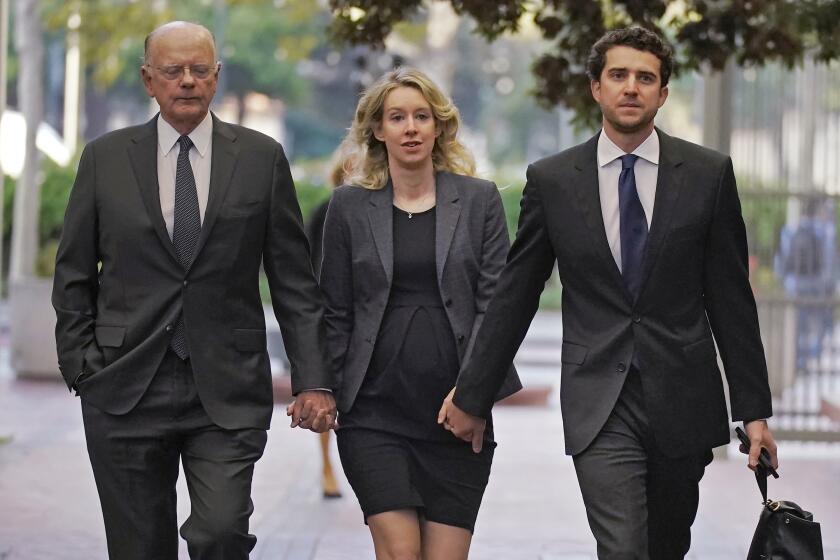Bugle Boy to Battle on New Fronts : The firm’s founder overcame personal and business woes to build a top clothing firm. : Now his company aims for new markets.
- Share via
William C. W. Mow sat in his Chatsworth office smoking cigarettes and trying to explain the strange detours in his life.
At 53, he’s attained a success that few will enjoy. As founder and chairman of Bugle Boy Industries, he runs one of the hottest clothing companies in America. Last year’s sales of $267 million should climb to $500 million this year, he predicts.
Teen-age boys and young men can’t seem to get enough of Bugle Boy’s casual clothes, snatching them from shelves at retailers as diverse as J. C. Penney and Bloomingdale’s.
“Right now everybody wants his product,” said Peter McGrath, young men’s apparel merchandising manager at Penney. “In the young men’s market, there really isn’t anybody they buck up against other than Levis. Kids want it.”
Along with L.A. Gear and Guess?, Bugle Boy is part of the powerful new California-influenced apparel business. Mow, who owns 90% of Bugle Boy, could probably sell the business tomorrow for $250 million or more, although he said he’s happy running a private company and has no plans to sell or go public.
Wanted to ‘Get Even’
Mow’s success is all the more remarkable because in the mid-1970s he was out of a job and the Securities and Exchange Commission had alleged that he had committed fraud by understating losses at a company he headed. Mow always denied the allegations, and his deft comeback owes much to something they don’t teach in business schools. Revenge.
“I wanted to get even,” Mow said, his lips tightening.
Thirteen years ago, Mow was working in what he believed would be his life’s work, electronics and computers. He ran a promising semiconductor testing equipment company that he had founded called Macrodata in Woodland Hills. But getting there hadn’t been easy.
Mow (rhymes with how) was born in China, the son of a Chinese diplomat later assigned to the United Nations. When he was 13 the communists swept to power, and Mow’s parents and five of their sons took refuge in New York. Bill Mow was quick at math, and he used that skill to bootstrap his way into electronics in the 1960s.
Then in the mid-1970s Mow’s life took another detour. Cutler-Hammer, a Milwaukee conglomerate, bought control of Macrodata; within a year, a $2-million understatement of losses at Macrodata was discovered, and Cutler-Hammer blamed Mow. He was forced to resign a week later as Macrodata’s president.
Cutler-Hammer got in touch with the SEC, which started its own investigation and eventually filed a civil lawsuit accusing Mow and other executives of fraud.
“I had nothing to do with it,” Mow said. He later filed suit claiming that it was Cutler-Hammer’s plan to make him a scapegoat.
To fight back in court he needed money. To get the money he needed to start a new business. “That was the motivation to develop a business,” he said. “To clear myself and to right the wrong.”
Through some fluky twists, Mow got into the clothing trade. His company almost went bankrupt a couple of times, and the lingering Macrodata headaches helped crack up his marriage.
Despite his personal troubles, after a decade and $400,000 in attorneys’ fees, Mow said, “justice was done.” Last year, a California appeals court essentially exonerated him, laying the blame for the accounting fraud scheme on Cutler-Hammer executives. All other appeals of the case have been exhausted.
In the meantime, Mow has carved out an empire for himself in a chaotic and fickle end of the fashion trade. Young people “have got the attention span of a flash bulb,” said Harry Bernard, a partner with Colton Bernard, a San Francisco consulting concern. About five years ago, when designer jeans started to lose their chic, Bernard said, “nobody was prepared to give younger kids a jeans alternative. Bugle Boy did.”
Inventive Advertising
The company, which imports clothes from about 15 countries including Taiwan and China, has made its stamp with reasonable prices (trousers start at $20), fast-changing styles and trousers with extra belt loops, jumbo pockets and “as many zippers and buttons and snaps as you can find. They captured that particular look,” Bernard said.
Bugle Boy has managed to drive home its message with inventive advertising in print and on television and with eye-catching bus stop posters.
Today, Mow is branching into men’s, children’s and women’s clothes, and he talks of hitting $1 billion in sales within five years. Despite Bugle Boy’s growth, however, Mow remains relatively unknown outside the apparel industry and is usually press-shy.
When it’s mentioned that clothing designer Ralph Lauren has achieved not only great wealth but great notoriety, Mow laughs. “That’s OK,” he said. “We sell more pants than he does.”
Mow’s father was chief of the military committee for Chiang Kai-shek’s Nationalist government and was working at the U.N. when Mao Tse-tung’s revolution took root. There was never much money after that, so Bill Mow worked his way through Rensselaer Polytechnic Institute in New York where he studied electrical engineering.
Discovered a Market
Later, after working at Honeywell near Boston, he followed his older brother Harry Mow--who worked at the RAND Corp. think tank--to Los Angeles. He eventually saw an opening for selling state-of-the-art semiconductor testing equipment and in 1969, Mow opened Macrodata. In five years, the company grew to $12 million in sales and counted most of the world’s major semiconductor manufacturers as customers.
But Mow’s life turned in April, 1976, when Cutler-Hammer executives confronted him with the alleged fraud and understated losses.
In 1978, Mow signed a consent decree with the SEC, neither admitting nor denying the allegations, but prohibiting him from any future violations of securities laws. Today, he says he did that “to get the SEC off my back.”
Legal Victory
Mow sued Cutler-Hammer for fraud, for scheming to buy his company for as little as possible by driving down its stock price and for trying to destroy his reputation. Several years later the company settled with him out of court. But the settlement was contingent, Mow said, upon the outcome of another suit filed against Cutler-Hammer--itself later bought by Eaton Corp.--by a group of Macrodata investors.
That case was concluded last year after a California appeals court upheld a $17.6-million judgment against Eaton. The judges ruled that Cutler-Hammer executives had intentionally understated Macrodata’s loss to pump up the parent company’s earnings, then blamed the accounting problems on Mow. Mow said Eaton paid him $820,000 to end his lawsuit.
A dozen years ago, Mow figured that his scarred reputation would hurt him in the computer industry, so he looked for something new. He had relatives in the garment trade, and when he met an American who had run a clothing company, Mow pulled together $200,000 from a Taiwan investor, put up his house to get a line of bank credit and in 1977, Buckeroo International opened for business.
But the first season, the company lost $300,000. At a fashion show that year, Mow remembers waiting in a booth for buyers to stop by. Nobody did. A couple of years before, Mow recalled, he made a sales pitch for semiconductor gear to Siemens executives “and that whole room doesn’t sit down till I sit down. Here I am sitting in a little booth tackling the buyers to look at the stuff.”
Powerful Duo
Mow could have used a few more tackles. Several years later, in 1981, his company lost $750,000, on sales of $4.1 million, and his marriage broke up.
Mow figured that he had maybe two more seasons to save the company. He changed the company’s name to Bugle Boy--after the Yankee kids who played the bugle during Civil War battles--and put Vincent Nesi in charge of sales. (Today Nesi is president and owns 10% of the company.)
Mow and Nesi have made a high-octane pair. Nesi joined Mow’s company a few months after the company opened and has worked his way up. Nesi has a reputation in the trade as a rough but savvy merchant. “Nesi is a tough guy to do business with, and difficult to work for, but he’s a very shrewd marketer,” Bernard said.
After half a decade struggling with the intricacies of the rag trade, by the early 1980s Mow had come up with a two-step strategy. “At the right price, you can sell anything. And keep it interesting.”
Bugle Boy started to grow, before almost collapsing in 1984. Parachute pants--baggy trousers made of nylon--were the rage, and Mow threw everything into making them.
Company Turns the Corner
“I cornered the nylon twill market in Taiwan. I virtually put the umbrella people out of business that year.” But the fad burst, returns piled up, and Bugle Boy had a negative net worth of $5 million. Working fast, the company brought out a new line of clothes only four months later, and department stores, eager to come back from their own parachute losses, filled their shelves. By then, Bugle Boy’s name had been in front of enough young buyers, Mow said, that the brand finally caught on, and with that season the company turned the corner.
Now Mow is pushing hard into the older men’s market because there are 2 1/2 times as many men between 25 and 49 than in the 15-to-24 age group. Mow said his line of clothing for older men is catching on and has helped Bugle Boy’s sales surge this year.
Some Complaints
But analyst Bernard said it’s unclear whether Bugle Boy can duplicate its success with young men in the older market. A more immediate chore for Bugle Boy is keeping store buyers happy. “Quite frankly, almost every (Bugle Boy) order is shipped late,” Penney’s McGrath said.
Mow said department stores are griping, in part, because his clothes are selling so fast Bugle Boy “can’t keep the pipeline filled.”
With Bugle Boy’s success, Mow appears to have mellowed. These days much of his energy is spent thinking about Levis, not his past. “Over time you develop something even better,” Mow said. “So you have to let the past go.”
More to Read
Inside the business of entertainment
The Wide Shot brings you news, analysis and insights on everything from streaming wars to production — and what it all means for the future.
You may occasionally receive promotional content from the Los Angeles Times.











